Related Research Articles

ColecoVision is a second-generation home video-game console developed by Coleco and launched in North America in August 1982. It was released a year later in Europe by CBS Electronics as the CBS ColecoVision.

Choplifter is a military themed scrolling shooter developed by Dan Gorlin for the Apple II and published by Broderbund in 1982. It was ported to Atari 8-bit computers the same year and also to the VIC-20, Commodore 64, Atari 5200, ColecoVision, MSX, and Thomson computers.

Donkey Kong Jr. is a 1982 arcade platform game that was released by Nintendo. It is the sequel to Donkey Kong, but with the roles reversed compared to its predecessor: Mario is now the villain and Donkey Kong Jr. is trying to save his kidnapped father. It first released in arcades and, over the course of the decade, was released for a variety of home platforms. The game's title is written out as Donkey Kong Junior in the North American arcade version and various conversions to non-Nintendo systems.

B.C. II: Grog's Revenge is a 1984 video game by Sydney Development for the Commodore 64, ColecoVision, Coleco ADAM, and MSX. It is the sequel to B.C.'s Quest For Tires and is based on B.C., the newspaper comic strip by Johnny Hart. The game was advertised for the Atari 8-bit computers, ZX Spectrum, BBC Micro, and Amstrad CPC, but those ports were never released.
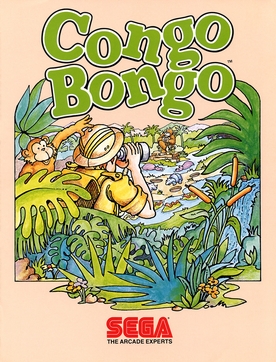
Congo Bongo, also known as Tip Top, is a platform game released as an arcade video game by Sega in 1983. A message in the ROM indicates it was coded at least in part by the company Ikegami Tsushinki. The game is viewed in an isometric perspective, like Sega's earlier Zaxxon (1982), but does not scroll. Numerous home ports followed.
Bump 'n' Jump is an overhead-view vehicular combat game developed by Data East and originally released in Japan as Burnin' Rubber. Distributed in North America by Bally Midway, the arcade version was available as both a dedicated board and as part of Data East's DECO Cassette System. The goal is to drive to the end of a course while knocking enemy vehicles into the sides of the track and jumping over large obstacles such as bodies of water.

Smurf: Rescue in Gargamel's Castle is a 1982 video game published and developed by Coleco for the ColecoVision and Atari 2600. The game is based on the television series The Smurfs. In the game, the player must brave a series of obstacles to rescue Smurfette from Gargamel's castle.

Antarctic Adventure is a video game developed by Konami in 1983 for the MSX, and later for video game consoles, such as the Family Computer and ColecoVision. The player takes the role of an Antarctic penguin, racing to various research stations owned by different countries in Antarctica.
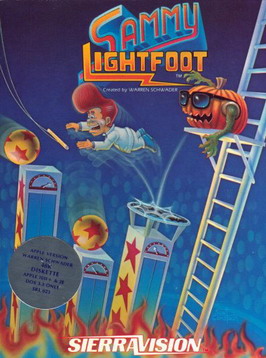
Sammy Lightfoot is a video game written by Warren Schwader for the Apple II and published by Sierra On-Line in 1983. It is a multi-screen platform game, in the vein of Donkey Kong. Sammy Lightfoot follows the travails of a circus worker who jumps and climbs through a number of perilous situations. It was initially ported to the Commodore 64 followed by ColecoVision and the PC-8800 series.

The Dam Busters is a combat flight simulator set in World War II, published by U.S. Gold in 1984. It is loosely based on the real life Operation Chastise and the 1955 film. The game was released in 1984 for the ColecoVision and Commodore 64; in 1985 for Apple II, DOS, MSX and ZX Spectrum; then in 1986 for the Amstrad CPC and NEC PC-9801.

Beamrider is a fixed shooter written for the Intellivision by David Rolfe and published by Activision in 1983. The game was ported to the Atari 2600, Atari 5200, Atari 8-bit computers, ColecoVision, Commodore 64, ZX Spectrum, and MSX.

Gateway to Apshai is an action-adventure game for the Commodore 64, ColecoVision and Atari 8-bit computers. It was developed by The Connelley Group and published by Epyx in 1983 as a prequel to Temple of Apshai. It is a more action-oriented version of Temple of Apshai, with smoother and faster graphics, streamlined controls, fewer role-playing video game elements, and fewer room descriptions.
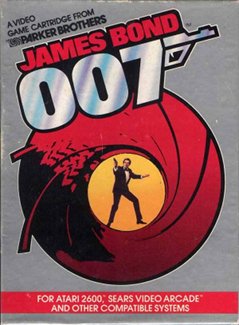
James Bond 007 is a horizontally scrolling shooter published in 1984 by Parker Brothers for the Atari 2600, Atari 5200, Atari 8-bit computers, Commodore 64, and ColecoVision. It was developed and published in Japan by Tsukuda Original for the SG-1000 under the title 007 James Bond. It was the first video game based on James Bond to be given a worldwide release.

The Dukes of Hazzard is a 1984 racing video game developed and published by Coleco for their ColecoVision game console and Coleco Adam computer. Elite Systems released a different game with the same title for the ZX Spectrum computer on February 23, 1985. Both versions are based on the television series of the same name.

Brain Strainers is a music video game released for the Atari 8-bit computers and Commodore 64 in 1983 and ColecoVision in 1984. It contains two sub-games, one of which is a clone of the popular 1970s audio game, Simon. It is notable for being one of the earliest music video games to employ pitch-based gameplay in the Clef Climber portion of the game.
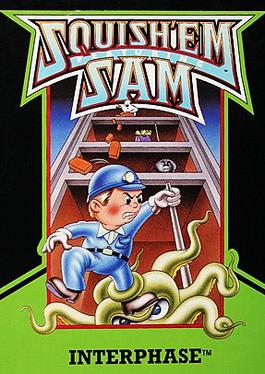
Squish'em, also known as Squish'em Sam, is a 1983 action game designed by Tony Ngo and published by Sirius Software for the Atari 8-bit computers, VIC-20, Commodore 64, MSX, and ColecoVision. The ColecoVision version plays digitised speech without additional hardware and was published as Squish'em Featuring Sam. The game is the sequel to Sewer Sam.
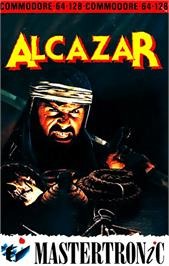
Alcazar: The Forgotten Fortress is a dungeon action-adventure game, similar to Dungeon Master and The Legend of Zelda. It was released in 1985 for the Coleco Adam computer along with a port for the ColecoVision. It was created by Tom Loughry from Activision, graphics by Keri (Janssen) Longaway. The game was also ported to the Commodore 64 later.

Pitstop is a 1983 racing video game developed and published by Epyx for the Atari 8-bit computers, ColecoVision, Coleco Adam, and Commodore 64. A sequel, Pitstop II, was released in 1984.

Jumpman Junior is a platform game written by Randy Glover and published by Epyx in 1983 for the Atari 8-bit computers and Commodore 64. In 1984, a port was released for ColecoVision in Australia, France, Germany, Italy and the UK. It is a follow-up to Jumpman (1983). While Jumpman has 30 levels, Jumpman Junior has 12–all of which are different from the previous game. The game was reduced in scope so it could be released in cartridge form.

Looping is an action game developed and published in arcades in 1982 by Video Games GmbH in Europe and Venture Line in North America. The player controls a plane across two phases in order to reach a docking station by destroying a terminal base or a rocket base to open a gate while avoiding obstacles along the way.
References
- 1 2 3 Hague, James. "The Giant List of Classic Game Programmers".
- 1 2 "Gust Buster". Gamebase 64.